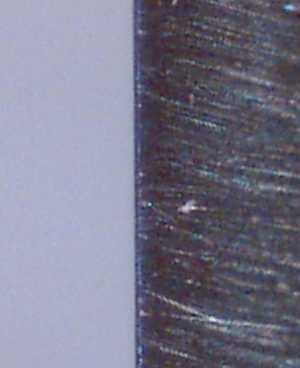|
| Knight high carbon steel |
|
| Finest abrasives. | ||
| Microbevels front and back. | ||
| Use a jig. | ||
| Copyright (c) 2002-15, Brent Beach |
Better than most high carbon steel blades.
Cryogenic treatment affects the internal structure of the steel, depending on the type of steel. Some doubt that it can have an effect on O1 steel. Some claim that it is a big help for A2 steel. In my tests, this is some of the best O1 steel, so it seems to have helped a bit. See the tests of A2 steel irons.
These blades receive a cryogenic treatment. At one time, Steve's web site discussed the process, but it no longer seems to. He does not say whether his current blades are cryogenically treated or not.
As with all my other tests, I honed three front and back bevels using 15, 5, and 0.5 micron 3M micro abrasive paper.
This iron can only be tested in a Knight plane. My Knight smoother has a 60 degree bedding angle. Typically, irons bedded at 60 degrees wear faster than irons bedded at 45 degrees. It is probably because with a high bedding angle the plane is taking more of a scraping action than a cutting action.
|
The front bevel, 200 X magnification, after the 0.5 micron paper.
These short thick irons are difficult to sharpen, and difficult to position under the microscope. Perhaps if all irons were this shape, I would have developed more suitable jigs. Having now done the Mujingfang blade, about the same length but only about half as thick, I might be able to do a better job taking pictures of Knight irons. |

|
|
The front bevel, 200 X magnification, after 100 passes along 4 foot douglas-fir board.
Very narrow wear bevel, about 4 pixels wide, with good edge quality. |

|
|
The front bevel, 200 X magnification, after 150 passes.
The wear bevel is about 6 pixels wide, the edge is still smooth. A very good result for a high carbon steel blade, especially given the high bedding angle. I don't know whether this is just better O1 steel than other O1 steel, or perhaps the cryogenic treatment does make a difference. |

|